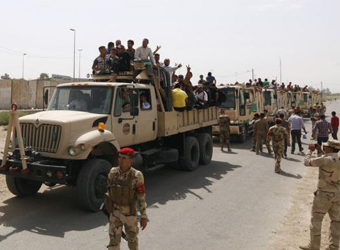Iraqi forces battled the Islamic State (IS) group in hours of heavy clashes in west Mosul on Sunday, as the number of people who fled fighting in the area topped 45,000.
Iraqi forces have recaptured several areas in west Mosul since launching the push to retake it on February 19, but their pace has slowed amid bad weather which muddies streets and makes air support more difficult.
West Mosul is the largest urban population centre still held by IS, followed by the city of Raqa in Syria and the town of Tal Afar, which is located between Mosul and the Syrian border.
The fall of west Mosul would effectively mark the demise of IS’s cross-border caliphate, which its leader Abu Bakr al-Baghdadi announced from a mosque in the city in 2014, but the threat posed by the jihadists would still be far from over.
Black smoke billowed over west Mosul on Sunday as Iraqi forces battled IS in a fight marked by explosions and continual automatic weapons fire.
In the course of the fighting, security forces targeted an approaching IS car bomb, detonating it and sending a fireball rising over the area, and also fired on a jihadist drone flying overhead.
“Rapid Response forces are moving toward important governmental buildings such as the governorate building and the police directorate,” Lieutenant Colonel Abdulamir al-Mohammedawi, a member of the elite interior ministry unit, told AFP.
The jihadists are using snipers, mortars and bombs planted in streets and houses, Mohammedawi said.
Al-Dawasa, which includes the Nineveh province governor’s headquarters and other government buildings was among several areas assaulted by Iraqi forces on Sunday.
The Joint Operations Command said the Rapid Response forces and federal police were attacking Al-Dindan and Al-Dawasa, while the Counter-Terrorism Service assaulted Al-Sumood and Tal al-Rumnan.
Lieutenant General Raed Shakir Jawdat later said in a statement that police- presumably along with forces from the Rapid Response Division-had advanced to within dozens of metres of the government buildings in Al-Dawasa.
The Counter-Terrorism Service and Rapid Response are two special forces units that have spearheaded most of the advances in the Mosul area.
The Iraqi army is also taking part in the fight for west Mosul, with the 9th Armoured Division advancing through the desert surrounding the city, aiming to cut if off from Tal Afar, farther west.
More than 45,000 people have fled west Mosul since the push to retake it began, while over 200,000 are currently displaced as a result of the battle to retake the city, which was launched on October 17, according to the International Organisation for Migration.
The IOM figures indicate the number of people who came from west Mosul to sites for the displaced from February 25, when the arrivals began, through Sunday.
More than 17,000 people arrived from west Mosul on February 28 alone, while over 13,000 came on March 3, according to the IOM.
On Saturday, Iraq’s minister of displacement and migration publicly criticised United Nations-led efforts to aid those displaced by the west Mosul fighting, while the UN said such assistance was the top priority.
“Unfortunately, there is a clear shortfall in the work of these (UN) organisations,” Jassem Mohammed al-Jaff said in a statement.
The UN, which has been providing shelter, food and other assistance to Iraqis who have fled Mosul during the nearly five-month-long battle, said it is working as fast as possible to help those displaced.
“The top priority for humanitarians is to make sure that there is sufficient capacity at emergency sites to deal with the number of civilians who are fleeing western Mosul,” said Lise Grande, the UN’s humanitarian coordinator in Iraq.
IS overran large areas north and west of Baghdad in 2014, but Iraqi forces backed by U.S.-led air strikes and other support have since regained most of the territory they lost.
Source: AFP
